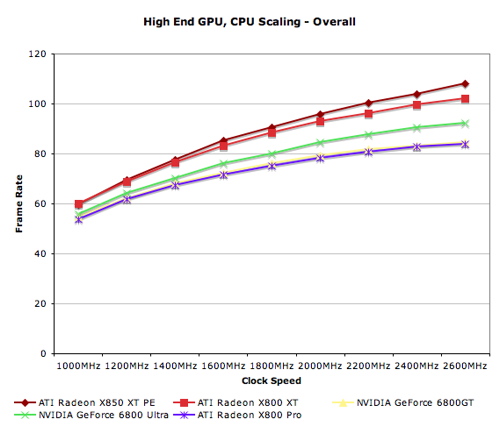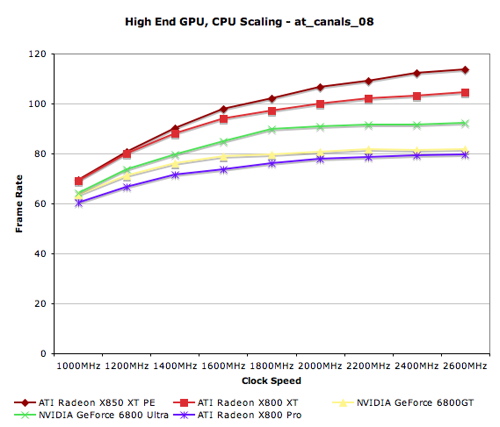CPU Scaling of Graphics Cards
In order to find out the dependency of various GPUs on fast CPUs, we took our Athlon 64 test bed and while keeping all variables the same, adjusted the clock speed from 1GHz all the way up to 2.6GHz. We ran two groups of cards across the entire spectrum of clock speeds in order to get CPU scaling curves on a per card basis.
The first group of cards were classified as "High End" cards and were all run at 1600 x 1200. All of the cards are graphed on the same graph as to help users determine at what CPU speed it makes sense to purchase a faster card.
The second group of cards were classified as "Mid Range" cards and were all run at 1280 x 1024. All of the cards are graphed on the same graph as to help users determine at what CPU speed it makes sense to purchase a faster card.
By no means were these charts meant to be all inclusive, but they should serve as a good guide for weighing CPU vs. GPU purchases. We also included a benchmark of Half Life 2 deathmatch in the results here using our own custom demo - at_mp_3.
All cards were run at the same high detail settings we performed our Half Life 2 GPU comparison under.
High End Graphics Card CPU Scaling
For our High End cards we’re looking at the Radeon X850 XT Platinum Edition, the Radeon X800 XT and Radeon X800 Pro from ATI. From NVIDIA we have the GeForce 6800 Ultra and GeForce 6800GT. We realize that this isn’t an all encompassing list of GPUs, but you should be able to extrapolate scaling of similar high end cards based on their performance relative to these five.
The most important graph is the first one as it is an average of all six of our Half Life 2 timedemos and gives you the best overall indication of CPU scaling of these GPUs on a holistic level. We have, however, included the individual charts for each timedemo for reference.

Interestingly enough, at 1600 x 1200, all of these high end GPUs scale quite similarly with CPU speed. We see that at lower speeds, the X850 XT PE performs identically to the X800 XT, it is only after you get above 2.2GHz on the Athlon 64 that the two even begin to separate. The same is not true for the GeForce 6800GT and Ultra, those two really begin separating much earlier on in the game.
















68 Comments
View All Comments
Phantronius - Wednesday, January 26, 2005 - link
#3NF4 will not be supporting AGP bud, sorry, its PCI-E from here on out.
Ozz1113 - Wednesday, January 26, 2005 - link
Ill backup the thought of putting some T-bred cores in there. My OC'd XP2600 333 w\ modded 9500 radeon system ran HL2 very well. I would have liked it to have been better, but it is not worth upgrading yet.Araemo - Wednesday, January 26, 2005 - link
Hehehe.. I'll fifteenth the "Please include an AXP3200+" sentiment. Personally, I'd rather see one or two AXPs included than a complete list of athlon64s.. You can generally extrapolate the performance of a given CPU if you are given two other CPUs with the same cache/FSB/core. I know that my Mobile barton handled the game fine, but I'd like to know how far behind a cheap A64 it really is.miketheidiot - Wednesday, January 26, 2005 - link
"Our standard 2-2-2-10 memory does actually offer reasonable performance benefits in Half Life 2 compared to DDR400 with higher timings such as 3-3-3-10 or the unrealistically high 3-6-6-10."Reasonable performance benefits? decent 2.5-3-3-10 ram can be found cheap nowdays (http://www.newegg.com/app/ViewProductDesc.asp?desc... and compared to the oczrev2 and other $200+ modules is at least $60 cheaper, in some case as much as $100 cheaper. The 2-2-2 is only 2% faster than the 3-3-3, so does that extra $60+ really offer "reasonable performance benefits"?
Jeff7181 - Wednesday, January 26, 2005 - link
#13... I wouldn't call that an error, I'd call that a difference in opinion. :)PrinceGaz - Wednesday, January 26, 2005 - link
There seems to be an error on page 4- "Almost all DDR400 these days is CAS 2 memory, but older memory may have a higher CAS latency..."Shouldn't it say "Almost all DDR400 tested by AnandTech is premium CAS 2 memory, but CAS 2.5 and CAS 3 are more common..."
Aquila76 - Wednesday, January 26, 2005 - link
What about SLI configs? I think people looking SLI for an option may want a better idea how their CPU choice affects the dual GPU choice. Can you add SLI'd 6600GT, 6800GT, 6800 Ultra benches to the tables at the end of your article?Tiamat - Wednesday, January 26, 2005 - link
Yeah, although probably unrealistic, tossing AXP's into a "low end range" comparison along side would help some people. Overall, great article!Regs - Wednesday, January 26, 2005 - link
I liked the Ram latency and 64-bit/128-bit test. But I'm wondering how would 2.5 Cas would perform? Makes sense to list it since a lot of value named brand ram modules come with 2.5 CAS. I would think it would perform in-between the two, but I'm having the slightest inkling that 2.5 CAS and 2.0 CAS will perform the same.Can't wait to hear about multithreaded games for dual core CPUs.
Jeff7181 - Wednesday, January 26, 2005 - link
Well we can look at the other HL2 articles cause there's an XP3200 in those... but... this being a CPU oriented article I thought it would be nice to have that CPU included. Possibly even an XP3000 so we can get an idea for how it scales so I can estimate how my 2.48 GHz Mobile AXP compares.